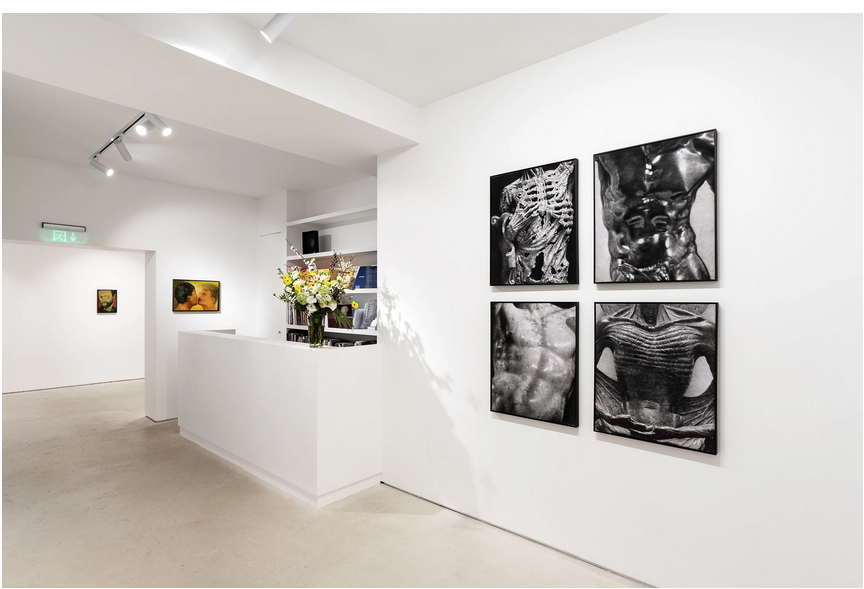Galerie Marguo is pleased to present The Hearing Trumpet, Part I, the first installment of a group exhibition gathering artists of Asian descent from the Americas and Europe. The title of the exhibition is adopted from the late Leonora Carrington’s fantastical novel The Hearing Trumpet (1974). The novel brings with its protagonist, the ninety-two-year-old Marian Weatherby who is nearly deaf, being forced into a retirement home, and ends in an ecstatic post-apocalyptic utopia peopled with all sorts of creatures and fantastical beings. In between, the reader is brought on an adventure that crisscrosses centuries and dimensions; encountering everything from a scheming New Age cult, a failed assassination attempt, a hunger strike, bee glade rituals, a witch’s sabbath, an angelic birth, and a quest for the Holy Grail.
An accomplished surrealist artist, Carrington was nevertheless dismissed in her time as a muse for male “geniuses.” Despite its emphasis on imagination and liberation of the mind, Surrealism was a movement that reinforced patriarchal social structures and objectified women. In the novel, Carrington tells the story of women ostracized from society for their old age and disabilities, who band together against all odds to celebrate their subversive power, nurture their souls, and find promises of joy.
In light of Carrington’s radical spirit — that expands not only our expectations of time and space, but also the boundaries of the human mind — the group exhibition brings together artists and cultural workers of Asian descent working in the West, who seek camaraderie, self-empowerment and visibility, and offers a space for healing, solidarity and celebration in a precarious time.
The participating artists include Pio Abad, Naotaka Hiro, Pearl C. Hsiung, Ce Jian, Yeni Mao, Tammy Nguyen, Anna Sew Hoy, Sean Shim-Boyle, XIE Lei, ZHANG Yunyao, and Ye Qin Zhu. Their works span all disciplines and articulate negotiations of multiple and sometimes clashing histories and identities, the processing of trauma and new awareness, and different notions of temporalities and spatialities that are informed by personal memories, collective experiences, and conceived in different social and cultural contexts.
Yeni Mao’s copper vessels reflect his investigations into architecture as the negative space that holds cultural memories, particularly the forgotten history of Asian immigrant laborers at the borders between Mexico and the US. His hanging sculpture presents the agency of materials, as well as layered readings imbued into an object.
Pio Abad’s practice is similarly concerned with the socio-political and historical significance embedded in objects. Decoy (2015), a seashell-encrusted CCTV camera, and 105 Degrees and Rising, a wallpaper designed with the US military camouflage and the image of a pinup girl, examine imperialist aggression through military power and soft power in geopolitical conflicts in Southeast Asia. Interrogations into the colonial past are also present in Tammy Nguyen’s paintings, which deconstruct the appropriated stereotypical imagery of Marlboro cowboys in the predatory campaign that swept not only the US but all of Asia with motifs of tropical vegetation.
Feeling the weight of the illness of COVID-19 and the surrounding political and cultural turmoil, Naotaka Hiro’s two paintings on plywood panel explore his own body part by part to process anxiety and confusion brought on by the pandemic.
Perhaps no one in the exhibition pays closer attention to the state of physical well-being than Sean Shim-Boyle, who has struggled with a rare heart condition. Like EKG sensors adhering to the skin to record cardiac activity, his text-based installation clings to the wall and spells out lubs and dubs — the rhythm of heart beats.
Ce Jian’s Lolly (2021) also addresses the human body, but focuses instead onits mechanical structure and the constructed visual culture of beauty. Elsewhere, Pearl C. Hsiung’s surrealist inspired paintings reference geological bodies that have been granted environmental personhood, ascribing human status to nature and underlining the anthropocentric logic in our belief system.
Anna Sew Hoy’s ceramics are adorned with personal items and fragmented texts, which not only index the process of clay making but also suggest personal memory, bodily sensations and
intimacy. And the sense of intimacy is also what XIE Lei’s quiet yet psychologically charged portraits elicit. The characters in the paintings seem confronted by an unsettling dual reality and
cognitive dissonance within their inner selves.
While Ye Qin Zhu’s highly texturized mix media triptych, inspired by temple reliefs and iconography, can be understood as a blueprint of the transmission of belief systems, cosmologies, and cultural legacies, ZHANG Yunyao’s paintings on felt that are created from a slow and
meticulous process of drafting and rubbing immortalize images by luminaries in Western arthistory.
The eleven artists’ eloquent articulations — expressed through material, object, mark-making and formal language — are resulted from their critical quest into the past and imaginative investment in
the present. Collectively, The Hearing Trumpet presents a site of fecund artistic and curatorial experimentation on diverse ways in search for knowledge and memory, as well as a space for us to
make our own claims within the global narratives of contemporary art, highlighting both hybridity and contradiction, in a hope to encourage future projects that challenge the stereotypes about
artists of Asian descent and enable a critical dialogue with the East and the West.
This exhibition is also a celebration of the creative agency that pushes the limits to re-imagine possibilities for representation, visibility and inclusivity. At the heart of The Hearing Trumpet is the collaborative spirit of community organization that has armed us to survive colonialism, racism, inequality, atrocities and natural disasters. In times of great uncertainty, we hope our presentation will radiate massive optimism and lift up all of us.
